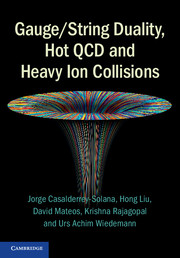Book contents
- Frontmatter
- Contents
- 1 Opening remarks
- 2 A heavy ion phenomenology primer
- 3 Results from lattice QCD at nonzero temperature
- 4 Introducing the gauge/string duality
- 5 A duality toolbox
- 6 Bulk properties of strongly coupled plasma
- 7 From hydrodynamics to far-from-equilibrium dynamics
- 8 Probing strongly coupled plasma
- 9 Quarkonium mesons in strongly coupled plasma
- 10 Concluding remarks and outlook
- Appendix A Green–Kubo formula for transport coefficients
- Appendix B Hawking temperature of a general black brane metric
- Appendix C Holographic renormalization, one-point functions, and a two-point function
- Appendix D Computation of the holographic stress tensor
- References
- Index
8 - Probing strongly coupled plasma
Published online by Cambridge University Press: 05 July 2014
- Frontmatter
- Contents
- 1 Opening remarks
- 2 A heavy ion phenomenology primer
- 3 Results from lattice QCD at nonzero temperature
- 4 Introducing the gauge/string duality
- 5 A duality toolbox
- 6 Bulk properties of strongly coupled plasma
- 7 From hydrodynamics to far-from-equilibrium dynamics
- 8 Probing strongly coupled plasma
- 9 Quarkonium mesons in strongly coupled plasma
- 10 Concluding remarks and outlook
- Appendix A Green–Kubo formula for transport coefficients
- Appendix B Hawking temperature of a general black brane metric
- Appendix C Holographic renormalization, one-point functions, and a two-point function
- Appendix D Computation of the holographic stress tensor
- References
- Index
Summary
As discussed in Sections 2.3 and 2.4, two of the most informative probes of strongly coupled plasma that are available in heavy ion collisions are the rare highly energetic partons and quarkonium mesons produced in these collisions. In this chapter and in Chapter 9, we review results obtained by employing the AdS/CFT correspondence that are shedding light on these classes of phenomena. In Sections 8.1 and 8.2, we describe how a test quark of mass M moving through the strongly coupled N = 4 SYM plasma loses energy and picks up transverse momentum. In Section 8.3 we consider how the strongly coupled plasma responds to the hard parton plowing through it; that is, we describe the excitations of the medium which result. In Section 8.4, we discuss calculations of the stopping distance of a light quark moving through the strongly coupled plasma. Throughout Sections 8.1, 8.2, 8.3 and 8.4 we assume that all aspects of the phenomena associated with an energetic parton moving through the plasma are strongly coupled. In Section 8.5, we present an alternative approach in which we assume that QCD is weakly coupled at the energy and momentum scales that characterize gluons radiated from the energetic parton, while the medium through which the energetic parton and the radiated gluons propagate is strongly coupled. In this case, one uses the AdS/CFT correspondence only in the calculation of those properties of the strongly coupled plasma that arise in the calculation of radiative parton energy loss and transverse momentum broadening.
- Type
- Chapter
- Information
- Gauge/String Duality, Hot QCD and Heavy Ion Collisions , pp. 261 - 346Publisher: Cambridge University PressPrint publication year: 2014



